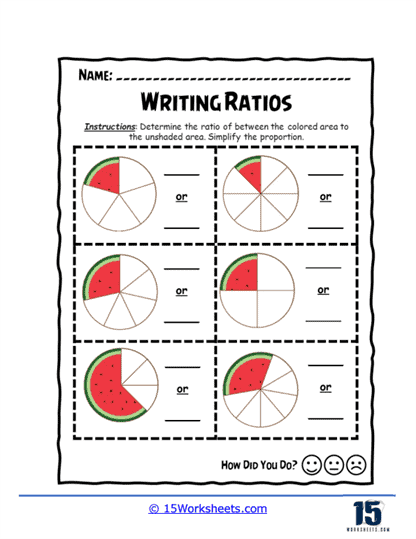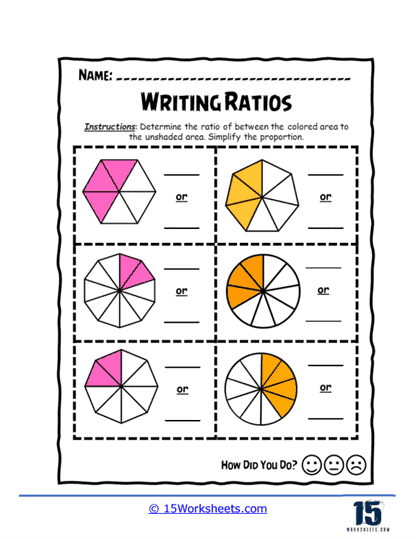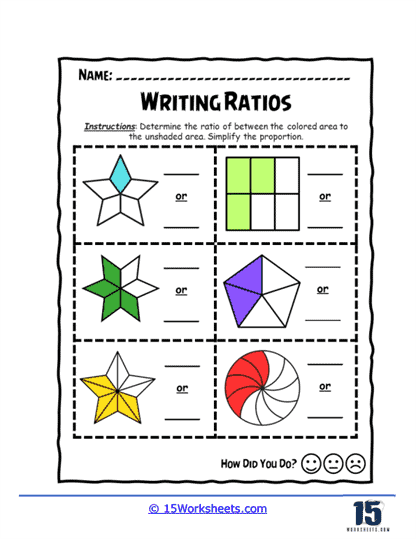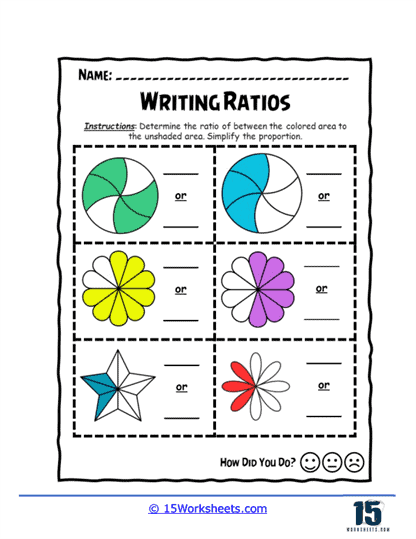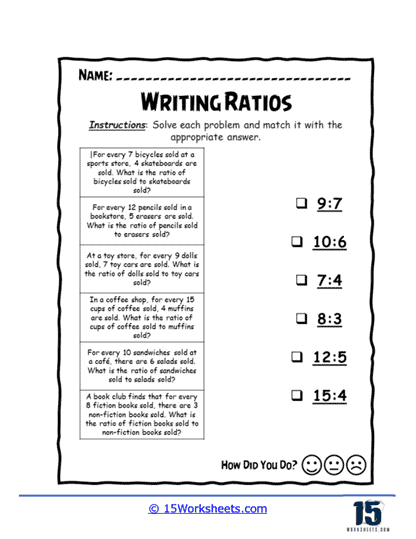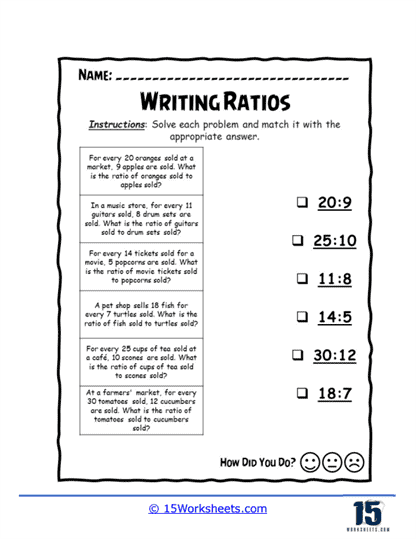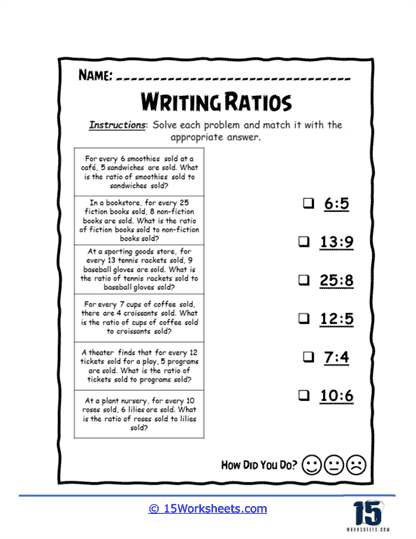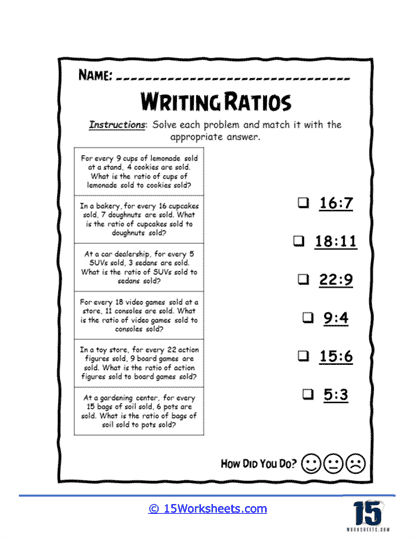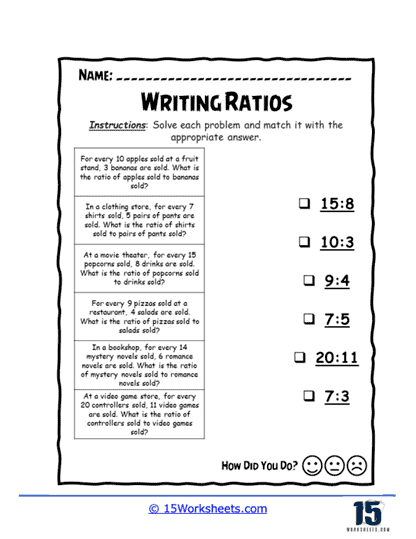Writing Ratios Worksheets
All About These 15 Worksheets
These worksheets will help students understand and practice the concept of ratios, a fundamental topic in mathematics. These worksheets aim to improve a student’s ability to identify, express, and manipulate ratios in various forms. Ratios are comparisons between two or more quantities, showing how much of one thing there is compared to another. This concept is essential not only in academic settings but also in many real-life situations, from cooking and shopping to business and engineering. The worksheets vary in structure and complexity depending on the level of the student, and they provide multiple opportunities for learners to develop a deep understanding of how ratios work.
Types of Problems
The types of problems found on these worksheets can range from very basic to quite advanced, catering to a wide range of age groups and skill levels. At their core, Writing Ratios worksheets include exercises where students are required to express ratios in their simplest form, write ratios from word problems, and compare different ratios. However, these worksheets can include many variations to help students gain a comprehensive understanding of the concept. Some of the most common types of exercises include:
1. Simple Ratio Writing
At the most basic level, students may be asked to write simple ratios based on provided information. These exercises might involve pictures or descriptions of objects where students must compare quantities. For instance, a question might show a picture of three apples and five oranges, asking the student to write the ratio of apples to oranges. Here, the student would need to recognize that the ratio is 3:5. These exercises help students get familiar with the basic structure of a ratio, understanding that it compares two quantities in a specific order.
2. Equivalent Ratios
Another type of problem involves finding equivalent ratios. This can be seen as the ratio equivalent of finding equivalent fractions. For instance, students might be asked whether 4:6 is equivalent to 2:3, and they would need to simplify or scale ratios to determine equivalence. This type of question helps students understand proportional reasoning and prepares them for more complex concepts in algebra and geometry. Mastery of equivalent ratios is critical for understanding concepts like scaling and percentages, which are frequently used in various fields.
3. Word Problems
Word problems are commonly found on Writing Ratios worksheets and provide context for applying ratios to real-world scenarios. For example, a problem might describe a classroom where there are 12 boys and 16 girls, asking the student to write the ratio of boys to girls. This type of exercise encourages students to translate verbal descriptions into mathematical expressions, a skill that is highly valuable in solving everyday problems. Word problems often push students to think critically about how ratios work in practical situations, thus reinforcing the utility of ratios in real life.
4. Writing in Different Forms
Students are often asked to express ratios in various forms, such as using the colon notation (3:4), fraction notation (3/4), or even in words (“3 to 4”). This flexibility is important because different situations and contexts require different forms of ratio expression. For example, in some cases, it might be more intuitive to use fraction notation, such as in recipes or when dealing with parts of a whole. In other cases, colon notation is more appropriate, such as when discussing comparisons between two separate quantities, like speed or density. Practicing writing ratios in multiple formats helps students become comfortable recognizing and using ratios in diverse scenarios.
5. Scaling Ratios
Scaling up or down is another critical aspect of ratio worksheets. Students are given a ratio and asked to find a new ratio by multiplying or dividing both terms of the ratio by the same number. For example, if the ratio of red to blue marbles is 2:3, the worksheet might ask how many red marbles there would be if there were 9 blue marbles. To solve this, the student would need to scale the ratio 2:3 up to 6:9. These problems are foundational for understanding proportionality, which plays a vital role in topics such as map reading, model building, and financial calculations.
6. Comparing Ratios
Some worksheets focus on comparing ratios to determine which is larger or smaller, or to identify if two ratios are equivalent. For instance, students may be asked whether the ratio 5:7 is greater than 3:4. Comparing ratios requires students to understand how to scale ratios to a common denominator or cross-multiply, which is a skill that has applications in many fields, such as determining the better deal when shopping or comparing statistics in sports or economics.
7. Ratio and Proportion Problems
Advanced worksheets may include ratio and proportion problems where students must use ratios to solve equations. For example, a problem might state that two quantities are in a ratio of 4:5 and give additional information that allows the student to set up a proportion and solve for an unknown variable. This introduces algebraic thinking and helps students grasp how ratios are related to more advanced mathematical concepts.
Using This Skill In The Real World
Ratios are a fundamental mathematical concept that play an essential role in helping people make informed decisions in everyday life. Understanding and applying ratios enables you to compare quantities, assess relationships, and find efficiencies in various aspects of life, from personal finance to cooking, fitness, shopping, and even time management. Here’s how understanding and writing ratios can make a significant difference in several real-world scenarios:
1. Personal Finance and Budgeting
One of the most critical applications of ratios is in managing personal finances. Whether it’s balancing income and expenses or determining how much of your paycheck should be allocated to savings, investments, or discretionary spending, ratios help you create a balanced financial strategy. For example, the 50/30/20 rule is a commonly used ratio for budgeting, where 50% of income is allocated to needs, 30% to wants, and 20% to savings or debt repayment. Understanding this ratio allows you to make better decisions by prioritizing where your money goes, ensuring financial stability over time. Similarly, credit utilization ratios (credit used/credit available) are important when managing credit cards, as a high ratio can negatively affect your credit score.
2. Cooking and Recipe Adjustments
Ratios are invaluable when cooking or baking, especially when adjusting recipes to fit different serving sizes. For instance, if a recipe calls for 2 cups of flour to make 4 servings, but you only need 2 servings, knowing how to apply ratios can help you halve all ingredients proportionally, ensuring the dish turns out correctly. Furthermore, baking often relies on precise ingredient ratios-such as the classic 3:2:1 ratio for pie dough (three parts flour, two parts fat, one part water). Understanding these ratios can help you modify recipes, experiment with flavors, and avoid kitchen disasters.
3. Health and Fitness
In fitness and nutrition, ratios are crucial for balancing your diet and exercise routines. Macronutrient ratios (the balance of proteins, fats, and carbohydrates) are used to tailor diets for specific goals, such as muscle gain or weight loss. For example, a typical macronutrient ratio for someone aiming to build muscle might be 40% protein, 40% carbs, and 20% fat. Similarly, when exercising, understanding the ratio between different types of workouts (e.g., 70% aerobic exercise to 30% strength training) can help you build a balanced fitness regimen, ensuring you meet your health goals without over-exerting any one aspect of your physical well-being.
4. Shopping and Comparing Costs
Ratios are essential when comparing prices to ensure you get the best value for your money. Unit pricing, which shows the cost per unit of weight or volume, allows you to compare products of different sizes and brands. For example, if one brand of cereal costs $4 for a 500g box and another costs $5 for a 600g box, understanding how to calculate the price per gram using ratios can help you determine which option is more cost-effective. This approach extends to a wide range of consumer decisions, including fuel efficiency (miles per gallon) when purchasing a car, or comparing the energy efficiency ratios (EER) of appliances like air conditioners.
5. Time Management and Productivity
Time management often involves understanding and using ratios to allocate your time effectively. For instance, the popular Pomodoro Technique uses a 25:5 work-to-break ratio, where you work for 25 minutes and take a 5-minute break. This ratio helps boost productivity and avoid burnout by balancing focused work with short rest periods. Similarly, managing a balanced schedule often requires dividing your time between work, personal life, exercise, and hobbies. Understanding these time ratios can help ensure that no single area dominates, allowing for a more harmonious and fulfilling life.
6. Risk Management and Decision-Making
Ratios are also useful in assessing risk and making decisions, especially in situations where outcomes are uncertain. For example, when weighing the potential returns of an investment against its risks, the risk-to-reward ratio (potential loss vs. potential gain) helps you make an informed decision. Similarly, if you’re considering taking on a new project at work, you can use ratios to compare the time and effort required to the potential benefits, helping you prioritize tasks that offer the greatest return on investment.
7. Health and Safety in Everyday Life
In areas like health and safety, ratios can help assess appropriate levels of caution or action. For instance, knowing the ratio of water to bleach in a cleaning solution can help you sanitize surfaces effectively without using too much or too little. In first aid, ratios are critical-such as the recommended compression-to-breath ratio of 30:2 in CPR (30 chest compressions followed by 2 rescue breaths). These ratios are vital to ensuring proper technique and can potentially save lives.
8. Travel and Fuel Efficiency
Understanding fuel efficiency ratios (miles per gallon or kilometers per liter) can help you make smarter decisions when planning trips or purchasing vehicles. For example, when deciding between two cars, knowing that one gets 30 miles per gallon and the other 40 miles per gallon allows you to predict how much fuel you’ll need and how much money you’ll spend over the life of the car. Similarly, ratios can help when planning travel routes, as comparing distance-to-time ratios lets you determine the most efficient way to reach your destination.
From the grocery store to the gym, ratios play a crucial role in decision-making processes in virtually every aspect of life. By understanding and applying ratios, individuals can make more informed choices, save money, optimize their time, and improve their overall quality of life. The versatility of ratios makes them an indispensable tool for problem-solving, comparison, and efficiency in the real world.



